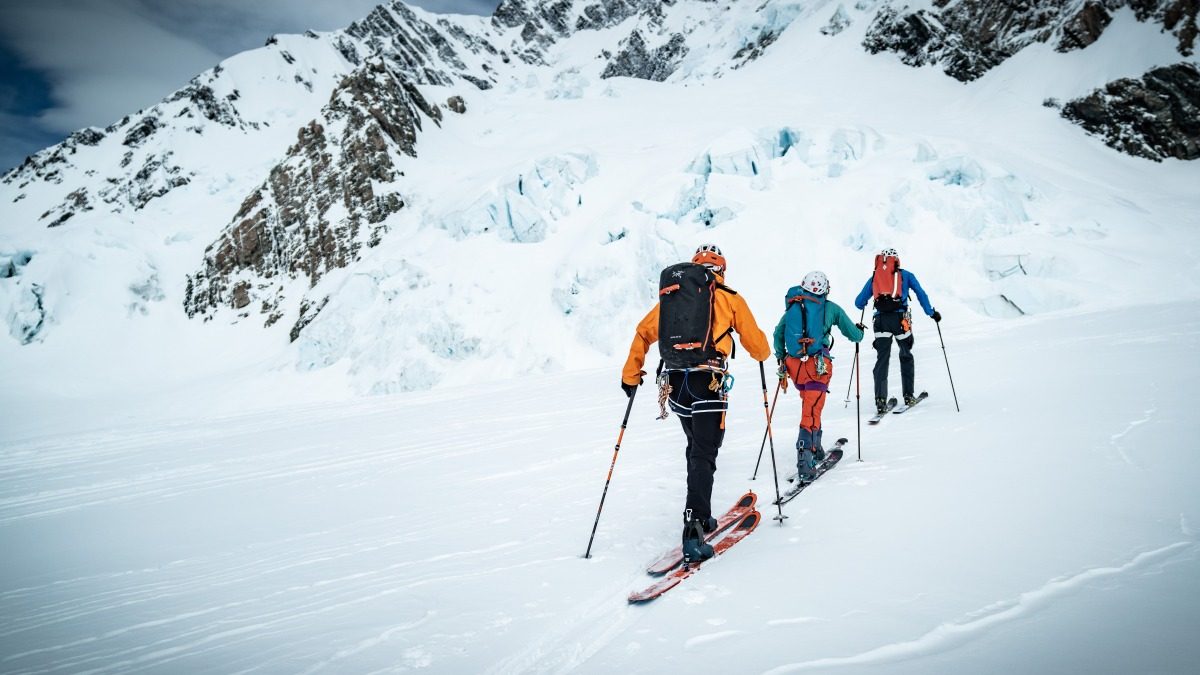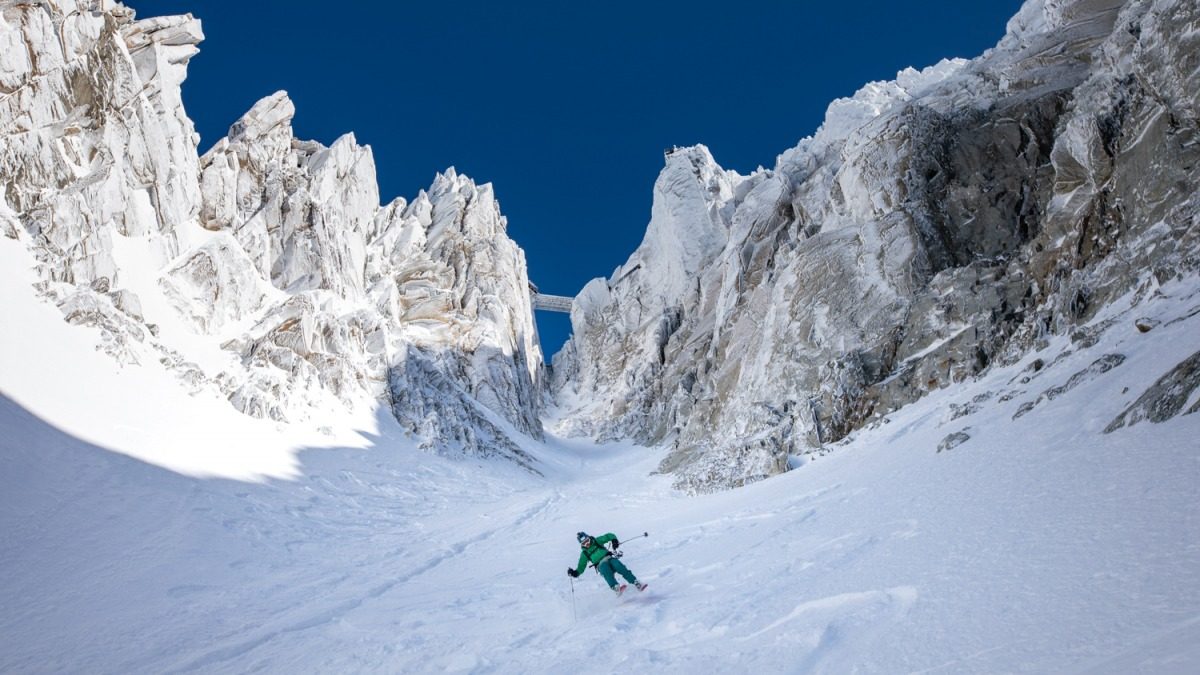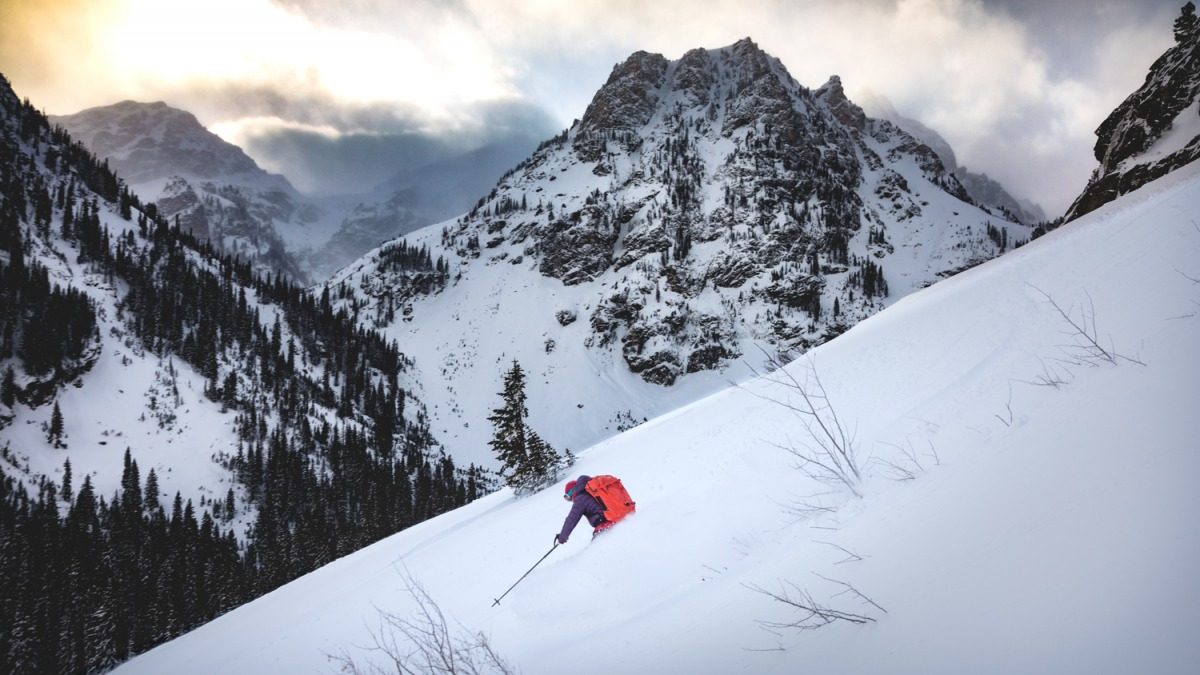
MTN Sense’s online courses are a starting place for some and a refresher for others. Smiley sees the platform as not replacing the need for guides or traditional classes. Photo: Mark Smiley
Notching into his fifth decade as a spry forty-year-old and father of two – Mark Smiley, the Jackson Hole based guide, has been a disruptor. That fashionable descriptor, “disruptor”, is often a term we associate with Left Coast tech, venture capital, and windfall IPOs. Not an affable alpinist-skier with scruff, an arsenal of puffies, and mountain know-how.
Smiley smashed that mold.
In his online offerings at MTN Sense, Smiley has developed and produced online mountain skill courses. Offerings range from a Worldwide Smartphone Navigation to The Ultimate Guide To Modern Alpinism.
Online learning is hardly the realm of disruption — it’s a ubiquitous tool. So why did it take so long for formal mountain skill training to come online? Maybe the answer lies in the tradition of guiding and teaching and everything unfolding in a high consequence physical world; gravity and weak snow-packs are unforgiving.
The genesis of MTN Sense was in July of 2015. “It was just two clients, Janelle [my wife] and I at the Alpamayo high camp,” said Smiley. The team summitted, and the clients, thrilled with their success, wanted more.
“I just started writing notes about what questions they had about climbing Denali,” he said. “Those questions or groups of questions then became the chapter titles to my first course. I had all this video footage because I’m always filming the experience, and although this is cliche, a picture’s worth 1,000 words, and the videos were worth 10,000. That was the start.”
My intention is not to put mountain guides out of work; it’s the opposite. It’s to increase the quality of guide work and increase the quality of guide safety,” added Smiley. “Because if clients show up more prepared, they are going to be able to apply this head-knowledge under a guide’s tutelage and get real-time feedback, which is 99% of the value that a guide provides. That it transfers from the brain to tactile to kinesthetic learning reinforces long term retention.”
As an IFMGA certified guide, Smiley won’t tell you that hands-on learning is obsolete. Or that navigating terrain with a guide for a day or ten in the mountains is not both a valuable learning experience and a means to build independent climbers or skiers.
One can imagine that around Jackson, egos are robust. It’s also easy to see how some might perceive Smiley’s enterprise removing guides from the learning equation. But convincing a burgeoning climber or skier to forgo hiring a guide or taking a formal class is not his intent. “My intention is not to put mountain guides out of work; it’s the opposite. It’s to increase the quality of guide work and increase the quality of guide safety,” added Smiley. “Because if clients show up more prepared, they are going to be able to apply this head-knowledge under a guide’s tutelage and get real-time feedback, which is 99% of the value that a guide provides. That it transfers from the brain to tactile to kinesthetic learning reinforces long-term retention.”
Intertwined in modern pedagogy are the multiple intelligences. In other words, intelligence is not binary. The basketball player with supreme court vision illustrates advanced kinesthetic intelligence. That empathetic nurse – they might have off-the-charts interpersonal intelligence. Without getting into the weeds, people learn and demonstrate mastery differently. One learner might prefer solitary reading, while another may prefer listening to an audiobook. Still, another may select a video.
Maybe mountain skill pedagogy is playing catch up. Smiley has tapped into a time-worn learning modality in video that just so happens to be relatively new to mountain skill education.
MTN Sense classes are linear in progression, allow the user to be self-paced, review material, and practice some skills (note the qualifier some) in a low-risk environment. In reality, it is no different than the first release of Freedom of the Hills in 1960, and that tome is in its ninth edition and runs 624 pages. The book is one tool among many that might best suit a backcountry skier or climber.

Dropping into the Cunningham (Passerelle) Couloir is not the first place Smiley wants his online enrollees to venture. Photo: Mark Smiley
Covid and its societal tremors remain a generational disruption. Unintentionally, Smiley positioned himself for the uptick in backcountry exploration. The MTN Sense platform afforded him a soft landing when his guiding opportunities vanished.
“It’s two marches ago, I basically got five emails, and my whole year shut down for guiding,” said Smiley of his full tilt towards his digital platform as Covid struck. “I’m self-employed; I’m on my own in that regard. And so I just had to fully pivot.”
At the time, Smiley says his catalog of courses was four to five deep. As the shutdown transpired, he buckled down, quickened his course development pace, and completed his first online avalanche course faster than intended. That course was released in the fall of 2020.
So far, the spectrum of MTN Sense courses is familiar to us. It’s the delivery vehicle that’s disruptive, not so much the content. That’s about to change.
The idea for Smiley’s new course, Beyond Level One: Backcountry ski touring decisions in the real world, has an origin story steeped in no longer accessing the best available avalanche forecast in his home mountains. Smiley had access to a tightly controlled Facebook group when he worked more frequently for a Jackson commercial guiding outfit. The company produced an avy forecast for guides only.
“It is cutting edge; it is awesome,” Smiley said of the private avy forecast and dialogue around it. “Last winter, I was not really guiding much, and I was bumped from the group. And then, I guided a few days and got put back in the group. I was like, phew, because the information is that good. The conversation is high level.”
The Beyond Level One course promises an intimate look into how professional ski guides collect online data in the morning and then make observations and decisions about where and where not to ski in the mountains. Think of it as a subscription to a guide’s vlog where their sole mission is to interpret the daily snowpack, head out and ski safely, and debrief. According to Smiley, the course will deliver five 10 minute video episodes featuring the guide’s ski day. Fifteen to 20 guides are onboard for the project.
Smiley doesn’t aim to replicate the gold standard avalanche forecast he once accessed. However, he intends to elevate the discussion around data collection, interpretation, and making actionable decisions based on that data. In the process, he hopes to demystify how professional forecasts are interpreted by guides and put to use in the field.

All the elements present in deep Wyoming: powder and great light. Mark Smiley’s online courses aim to get users into these places while making safe decisions. Photo: Mark Smiley
For now, extensive online mountain education courses are rare. Yet Smiley expects others to enter the digital education space. “I mean how many universities are there in the U.S.?” he asked when contemplating the potential for competition.
Just scratching the surface of online education is a wormhole. And one that has professionalized. That Smiley tapped into an unfilled niche is evident. On the cusp of developing a curriculum like this, Smiley understands the tenuous nature of what he is presenting; enrollees might feel that engaging in an online class is their ticket to unfettered adventure.
Back in 2019, WildSnow reviewed the MTN Sense ski mountaineering course and commented on the format’s pros and cons. The author’s words still ring true.
“Limited opportunities for assessment,” wrote Manasseh Franklin about the course. “This is where the online aspect gets tricky. “Outdoor education is by nature experiential. The lion’s share of its value comes from hands-on practice in low consequence environments where students can mess up and learn.”
Mountain culture is steeped in self-reliance. So, like any reputable guide, Smiley says his courses warn and inform, putting it back on to the user to take personal responsibility.
Yet, he does not want course enrollees to repeat what he has illustrated and have a bad outcome. “This can kill you; context is huge here; you’ve got to make good decisions,” Smiley said when thinking about how to apply what MTN Sense offers. “If you’re not comfortable making these decisions, hire a guide, or review the course material, which won’t solve all your problems, but it might shed a little bit more light.”
MTN Sense is one model of remote learning for adventuring in remote places, and it is additive when considering how we learn. For many, it makes sense.
Jason Albert comes to WildSnow from Bend, Oregon. After growing up on the East Coast, he migrated from Montana to Colorado and settled in Oregon. Simple pleasures are quiet and long days touring. His gray hair might stem from his first Grand Traverse in 2000 when rented leather boots and 210cm skis were not the speed weapons he had hoped for. Jason survived the transition from free-heel kool-aid drinker to faster and lighter (think AT), and safer, are better.
